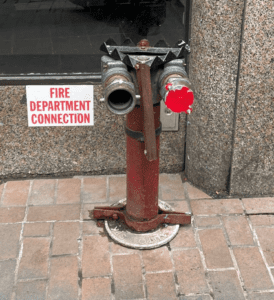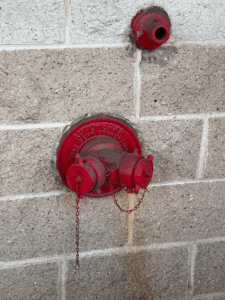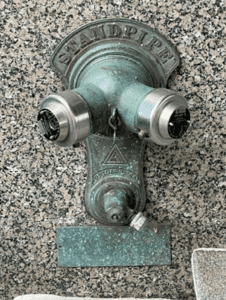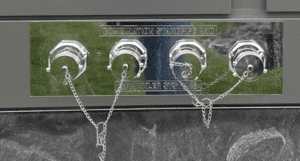Understanding Fire Department Connection Sign Requirements

The Magic Number is Three
 When it comes to fire department connection sign requirements, we must first address who the signage is for, and its intended use. The reason for placing signage on a fire department connection (FDC) is to provide the end user or fire department some basic information about the fire protection system installed within a building or structure. This allows them to properly understand what type of system is in the building, pressure requirements needed to properly supplement, or supply that system demand, and which areas are being served during an emergency.
When it comes to fire department connection sign requirements, we must first address who the signage is for, and its intended use. The reason for placing signage on a fire department connection (FDC) is to provide the end user or fire department some basic information about the fire protection system installed within a building or structure. This allows them to properly understand what type of system is in the building, pressure requirements needed to properly supplement, or supply that system demand, and which areas are being served during an emergency.
Many jurisdictions see this as an opportunity to amendment the requirements locally and go well beyond just the minimums set by the standard. Some of these amendments are valuable, but many just lead to jurisdictional confusion or unnecessary information. Simple placing an additional sign stating “FDC” does not add value and is not a requirement found in the standards. Consideration should be given to truly needed information for emergency operations, and basic owner concerns like building aesthetics.
Fire department connection sign requirements serve to illustrate three things:
- System type, including if a standpipe is manual wet or dry
- System demand pressure if greater than 150psi
- Where FDCs service only a portion of a building or multiple buildings
The first item is simple: what type of fire protection system is being supplemented or supplied by the FDC. There are again three major options, a sprinkler only system, a standpipe only system or a combined sprinkler/standpipe system, each with a specific requirement for signage.
The sprinkler only system
 Note: we have three sprinkler standards to reference when looking for guidance on FDC signage requirements.
Note: we have three sprinkler standards to reference when looking for guidance on FDC signage requirements.
NFPA 13: Standard for the Installation of Sprinklers, and NFPA 13R: The Standard for the Installation of Sprinklers in Low-Rise Residential Occupancies, requires an FDC to be marked AUTOSPKR with 1-inch letters on the plate or ring. This sign indicates a sprinkler only system that is pressurized at 150 psi and used to supplement the automatic sprinkler system.
In contrast, NFPA 13D: Standard for the Installation of Sprinkler Systems in One- and Two-Family Dwellings and Manufactured Homes, does not have any requirements for FDCs or signage for an FDC.
The standpipe only system
 NFPA 14: Standard for the Installation of Standpipe and Hose Systems requires a standpipe only FDC to be marked STANDPIPE with 1-inch letters on the plate or ring. There is an additional requirement to mark a manual standpipe as either wet or dry. This additional requirement is a critical key in determining if the system is to be supplemented or requires it to be fully supplied by the fire department.
NFPA 14: Standard for the Installation of Standpipe and Hose Systems requires a standpipe only FDC to be marked STANDPIPE with 1-inch letters on the plate or ring. There is an additional requirement to mark a manual standpipe as either wet or dry. This additional requirement is a critical key in determining if the system is to be supplemented or requires it to be fully supplied by the fire department.
The combined sprinkler/standpipe system
The requirements for combined systems are also found in NFPA 14. They are marked STANDPIPE AND AUTOSPKR or AUTOSPKR AND STANDPIPE and once again with 1-inch letters on the plate or ring. This designation indicates that the system is a combined sprinkler/standpipe system. Combined systems also have the additional requirement of designating if the standpipe portion of the combined system is manual, as either wet or dry. This is again key to understanding if the system is automatic and needs to be supplemented or manual and must be fully supplied. These FDCs are initially pressurized at 150psi with a correlation for evaluation and fire department hose/nozzle specifications used during fire operations.
 The second item required is the pressure needed to supply system demand. The standard practice is to provide all FDC with 150 psi at the connection. Therefore, the standard only makes this a sign requirement when system demand exceeds 150psi. This requirement is found in all three of the standards with FDC and FDC signage requirements (NFPA 13, 13R and14).
The second item required is the pressure needed to supply system demand. The standard practice is to provide all FDC with 150 psi at the connection. Therefore, the standard only makes this a sign requirement when system demand exceeds 150psi. This requirement is found in all three of the standards with FDC and FDC signage requirements (NFPA 13, 13R and14).
The third requirement is only found in NFPA 14. It requires that where a FDC serves multiple buildings, structures, or locations, it shall indicate the locations served on a sign. This would apply to all standpipe only and combined sprinkler/standpipe systems. This requirement addresses the building or structure that has unique features and areas served or not served by the systems which are in or outside of the expected coverage areas.
The information gained from the fire department connection and the required signage on those connections is required for fire service operations during an emergency and must be valuable in nature. As we see in the signage requirements for pressure, many items are specifically not indicated by signage because its already known by the user.
The NFSA is Your Resource for Fire Protection Codes and Standards
From fire department connection sign requirements to hangars and bracing and hydraulic calculations, the NFSA is your premier resource for fire protection codes and standards. Our Codes and Public Fire Protection Department keeps up-to-date on all developments in all standards and works to make the buildings safer.
Our team also offers an Expert of the Day codes and standards interpretation service to members who have a codes question.
Not a member? Visit our membership page to join.
